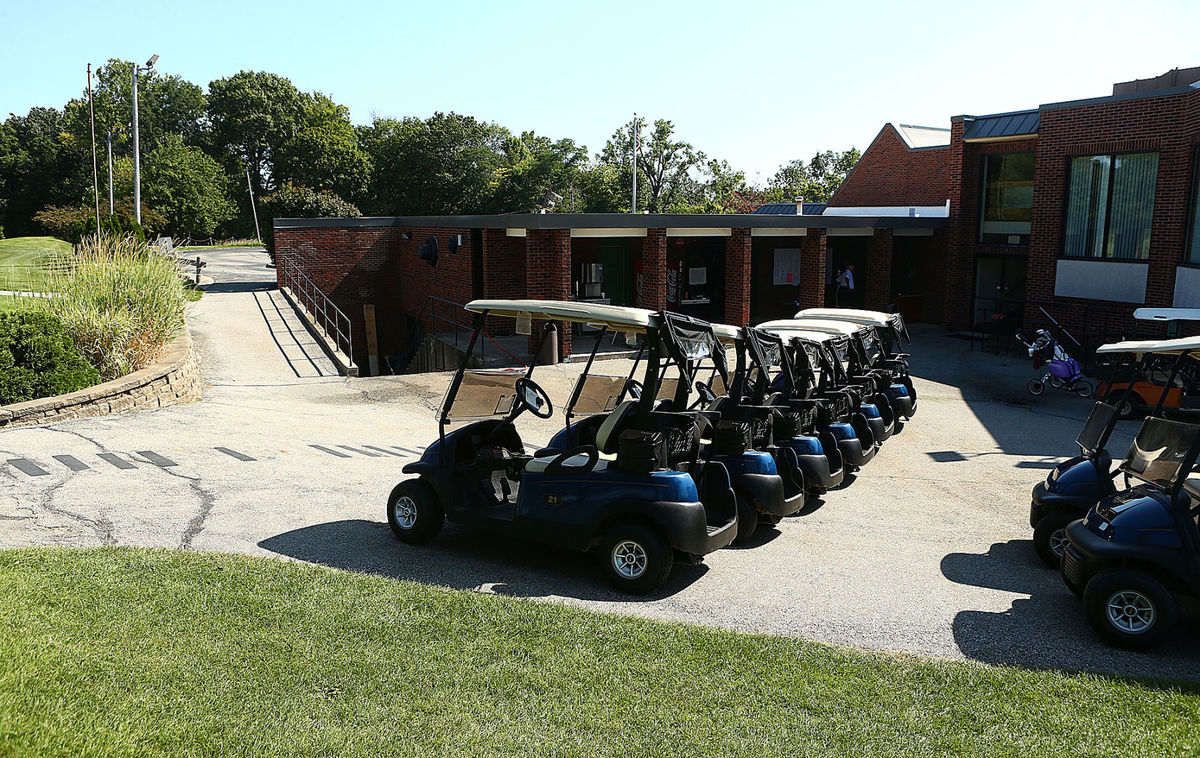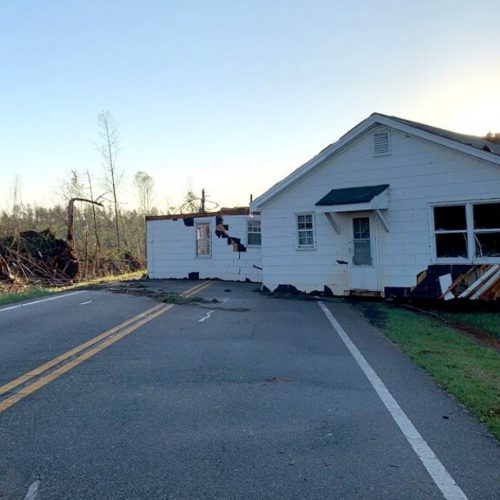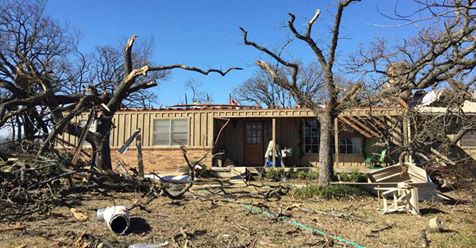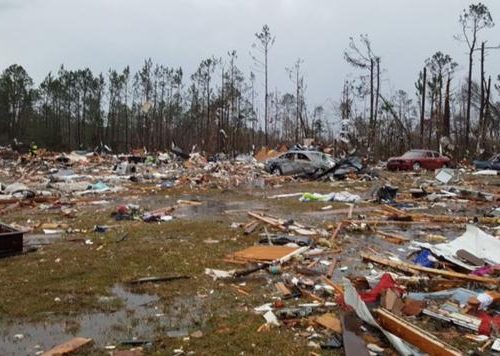KOKOMO – It’s a day that will never be forgotten in Kokomo.
Aug. 24, 2016, will be remembered for its destruction, the splintered homes spread across roadways, the Starbucks that collapsed like a deck of cards. It will be remembered for the terror given to those who had, only three years earlier, experienced the exact same thing.
But it also will be remembered for the community response, the helping hands provided to those most in need.
The morning after the tornado, community organizations gathered together at the United Way of Howard County to implement a plan for disaster relief.
Organizations included the Red Cross, the Salvation Army, the Kokomo Rescue Mission, the Howard County Emergency Management Agency and several others. The groups were tasked with addressing the community’s immediate disaster-related needs.
Within hours, the emergency shelter was set up at the Kokomo Event and Conference Center. Within days, a warehouse was set up at the old General Motors building on Boulevard Street to house and distribute water, food and basic household items for people affected by the tornado.
The organizations continued to meet at the United Way for several days, updating each other on the ways that needs were being met around the city, including who was taking care of tree removal, who was providing new mattresses and furniture and updates on available rentals in the area.
The process wasn’t created out of thin air, said Abbie Smith, president of the United Way of Howard County. The organization has an entire binder dedicated to disaster situations like the tornado, and Smith said it comes down to three main phases: preparedness, response and recovery.
Smith stressed that the response and recovery efforts have not been the United Way’s alone; it was a community effort, bringing together leaders and organizations from in and around Howard County, as well as some volunteer groups from outside of the state.
One key aspect of the immediate community response was the Tornado Recovery Warehouse, set up by the Kokomo Rescue Mission in the empty GM building on Boulevard Street.
Pam Givens, the chief administrative officer for the Kokomo Rescue Mission, said the space was perfect for the warehouse. It had a loading dock and plenty of room for the donations that continued to pour in.
The warehouse served over 1,000 people over the course of six weeks. With help from Robert Miller & Son Furniture and Lucas Furniture, the Rescue Mission was able to give out over $21,500 in furniture vouchers and new mattresses to families whose homes had major damage or were destroyed.
Givens said the mission shouldered more than $51,000 in expenses related to the tornado, and received more than $40,000 in donations for recovery efforts. Aside from the financial stress, the staff and volunteers at the Rescue Mission were working longer hours than usual and going door-to-door in the hardest-hit areas of the city.
Despite the added stress, Givens said she was glad to be a part of the recovery process.
“I’m so blessed to see how things work out,” she said. “To see how generous this community is. It took its toll on us, but we’re good.”
One of the biggest roles the United Way has played in the recovery effort has been managing monetary donations and handling the caseload of affected people through 2-1-1. By calling 2-1-1, people can find referrals for a number of needs, and the service saw a spike in calls immediately after the tornado. Last August, 2-1-1 received over 1,700 disaster-related calls.
The people calling 2-1-1 were looking for housing, household items, food and furniture. Some were needing help dealing with their insurance companies. Others were looking for financial assistance to rebuild or repair damaged homes.
Overall, through 2-1-1, the organization opened 385 cases related to the tornado, and they hired Stephanie Berghoff to oversee case management. As of Monday, Aug. 14 of this year, the case load was down to 37 open cases.
One of the things she didn’t expect to see, she said, was the emotional toll the tornado took on people. She’s been working with people day in and day out to meet their physical needs, but people are also sometimes looking for someone to just listen, she said. 2-1-1 can help with referrals for counseling as well.
Moving forward, 2-1-1 will continue to accept calls related to the tornado damage until Sept. 30. After that date, no new cases will be opened related to the Aug. 24, 2016, tornadoes, but Berghoff said there will likely still be a few ongoing cases, and people can still call 2-1-1 for other needs.
Smith said the community is starting to move back into the preparation phase, meaning organizations such as United Way are preparing for future disasters.
Here is a look at recovery efforts undertaken by others in the community:
Kokomo Country Club
Sustaining massive tornado damage last year was the Kokomo Country Club and its 18-hole golf course. Downed trees littered the golf course after the tornado, leaving huge divots and holes across the course’s greens.
Club manager Tony Tutela said at the time that the clubhouse sustained extensive damage, including broken windows, malfunctioning air-conditioning units on the roof and sagging ceilings in the ballroom. The swimming pool also suffered an estimated $400,000 in damages.
The course’s front nine holes were determined to need a total overhaul. Some of the county’s oldest trees were uprooted.
“The building is fixable. You can replace the windows and a couple of air conditioners,” Tutela said last August. “But that course out there, that’s hundreds of years old. It’s gone. It will never be the same again in our lifetime.”
Tutela was a bit more positive in an email Friday.
He noted that the club is back to 100 percent active in all outlets and amenities for guests and members.
“The Banquet Ballroom has been finished as well as the roof, windows, carpet throughout the entire Club,” he said. “The pool has been completely renovated and the pool heater has been fixed.
“All the furniture around the pool has been replaced, umbrellas, chairs, chaise lounges, tables, etc.”
Most notably, Tutela explained that the golf course is “back to 100 [percent],” a feat that wasn’t predictable only a year ago.
The club, he said, has planted over 100 new trees and is planning for another 50 this fall, and is advertising new introductory memberships to generate new interest and will soon open to the public to see the refurbished clubhouse.
Parks and rec
One of the most devastated places in Kokomo was Highland Park, which saw the destruction of more than 60 mature, 100-year-old trees.
Additionally, the two baseball diamonds primarily used by little league teams were left substantially damaged, including mangled fences and netting, flipped bleachers and downed light poles. Two playgrounds were almost completely destroyed, including the handicap-accessible playground.
But the destruction that caused the most irreplaceable damage? Former Kokomo Parks and Recreation Superintendent Randy Morris said the twister uprooted more than 60 of the park’s massive, mature trees, most of which were more than 100 years old. Now, only 10 remain in the entire park.
In total, around half of the park sustained damage from the tornado, he said.
Since then, though, the parks and recreation department has taken substantial steps in the recovery process.
Through the city’s Rebuild Highland Park Fund, officials raised roughly $90,000 and planted around 225 trees, with more to come this fall.
Additionally, the city opened a new ADA-compliant playground earlier this year in Highland Park, establishing a state-of-the-art space in an area that one year ago was left ravaged and unusable.
Other projects included efforts from Duke Energy volunteers, who in March raised two 55-foot lights poles at the Southside Youth Baseball League ballpark to replace two that were downed during the Aug. 24 tornadoes.
“That’s kind of what Kokomo is and is about,” said Kokomo Parks and Recreation Superintendent Torrey Roe in a previous interview. “We’ve always stepped up to help our neighbor, and unfortunately, this time it was Highland Park that was that neighbor.”
“We live in such a great community that people are willing to give and help one another, and that’s what makes this community so great.”
However, it’ll be decades before the park resembles what it looked like before last August, as the young trees were planted with trunks about two inches in diameter. That’s compared to the 10 remaining trees in the part that have been alive for over a century.
“The beauty of what the south side of Highland Park was, our children will … see that down the line in the future, but it’s going to take years to get there,” said Roe.
“We want Highland Park to return back to the beauty that it once had.”
Garden Square Apartments
Garden Square Property Manager Emilee Norris said it was hard to take in the destruction at the 176-unit apartment complex after emerging from a bathroom in the community building, where she hunkered down during the tornado.
Limbs and branches from more than 20 trees, along with roof shingles and other debris, littered every inch of the grounds, making it impossible to navigate the property located along Firmin Street.
A quick but thorough tour into every building revealed no one was injured, though.
“There were so many things that could have happened,” Norris said. “How we all remained uninjured is just beyond me.”
Although the damage added up to at least $1 million, no residents ended up being displaced. There were enough open units to place people whose apartments had been damaged beyond immediate repair.
Thirteen units ultimately sustained too much damage to immediately reopen. Five required a total overhaul, including new windows and flooring. The community building also sustained massive water damage and required a full-blown renovation.
Now, after nearly a year, almost all those units have reopened. Norris said all the damaged apartments should be fully renovated by the end of September.
Out of around 60 trees on the property, 20 had to be cut down. Since then, 20 saplings have been replanted throughout the complex.
Norris said although the tornado damage was significant, it could have been much worse, considering none of the buildings sustained structural damage.
“There was no demolition or reconstruction required,” she said. “It all just required a remodel.”
Red Cross
One organization with an indispensable role in tornado recovery and victim-support was the American Red Cross.
Red Cross Indiana Regional Communication Director Duchess Adjei explained the Red Cross’ response on Aug. 24, 2016.
“It started as a chapter level response using volunteers in Kokomo and Howard County,” she said. “Realizing the scale of the tornadoes we utilized all volunteers across the region to support efforts within the house. We set up the Kokomo Event and Conference Center shelter in less than two hours.”
Adjei said there were, in total, 362 overnight stays at the shelter. In addition to sheltering tornado victims, the organization provided both food and client services, including mental health and health services.
Other figures included: 7,161 meals; 10,836 snacks; 212 clean-up kits; 402 comfort kits; and 3,178 bulk items (tarps, shovels, masks, gloves, bleach and more).
“We have a brand new office in the community and are always continuing to provide the full breadth of Red Cross services to include: Disaster Relief Services, Health & Safety Services, Military and Veteran support to individuals and their families, Blood Services and International Services,” wrote Adjei in an email.
by Caele Pemberton, George Myers and Carson Gerber
August 20, 2017





